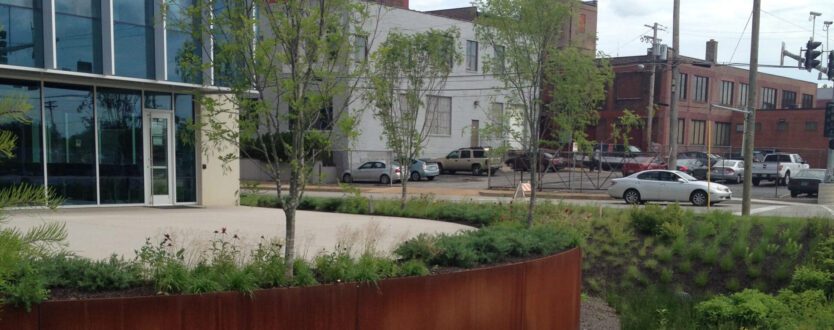
Placemaking + Landscaping
A neighborhood is more than a collection of buildings and infrastructure. The public spaces in between are a vital part to the success of the District.
Ideal Future State
Cortex is an exciting and vibrant neighborhood and a preferred bike/pedestrian route through the City.
Why Important
Public spaces present an opportunity to reduce the water and energy normally required to maintain such areas. In addition, these spaces create the first impression and should be designed to make everyone feel welcome.
Objectives / Targets
- Target at least one distinct placemaking experience on every block within the district. There should be a variety of privately-owned, publicly-open spaces (POPOS) for public use.
- 20% of non-street areas of District (+20 acres) dedicated to common areas or access to green space (Currently, streets and parking make up 50% of the District).
- Close to cars, transform, or convert 25% of previously car-centric spaces to public open areas.
- Obtain robust participation during programmed events.
- Regularly have 25 people per acre during regular business hours (5000 people in District).
- Provide a diversity of uses and types of public spaces (eating, recreation, gathering, contemplation).
- Reduce potable water use in landscaping by 100% by 2030 (drought-tolerant, xeriscaping, swales).
- Access to nature is improved and equitable; public spaces are high-quality, engaging and active.
- Require a maximum distance (5 min walk) from any point in an urban area to a public park/green space.
- Require the elimination of invasive species planting.
Indicators
- Envision Sustainable Infrastructure Rating System; Public participation and activity
- Low Impact Development Guidelines (lowimpactdevelopment.org); Milkweeds for Monarchs.
Baselines
While there is no current baseline for placemaking or landscaping, this becomes an opportunity for incorporating equity within the District, and we need to set or determine a proper baseline that is both inclusive and attainable.
Future Targets
- Provide mapped POPOS to the public by 2026
- Reduce potable water use in landscaping by 100% by 2030
- Eliminate toxic pesticides and gas-powered mowing
Immediate Steps
Create and post initial map of public spaces to invite their use by a diversity of audiences.
Short-Term Steps
Establish landscaping and low-impact development guidelines.
Long-Term Steps
Develop sustainable infrastructure guidelines (Envision) requirements.
Challenges
- Cortex should think of ourselves as a destination and develop tools and resources to amplify and showcase these amenities.
- We should be using our permit approval tools to push a lush landscaping and placemaking agenda

